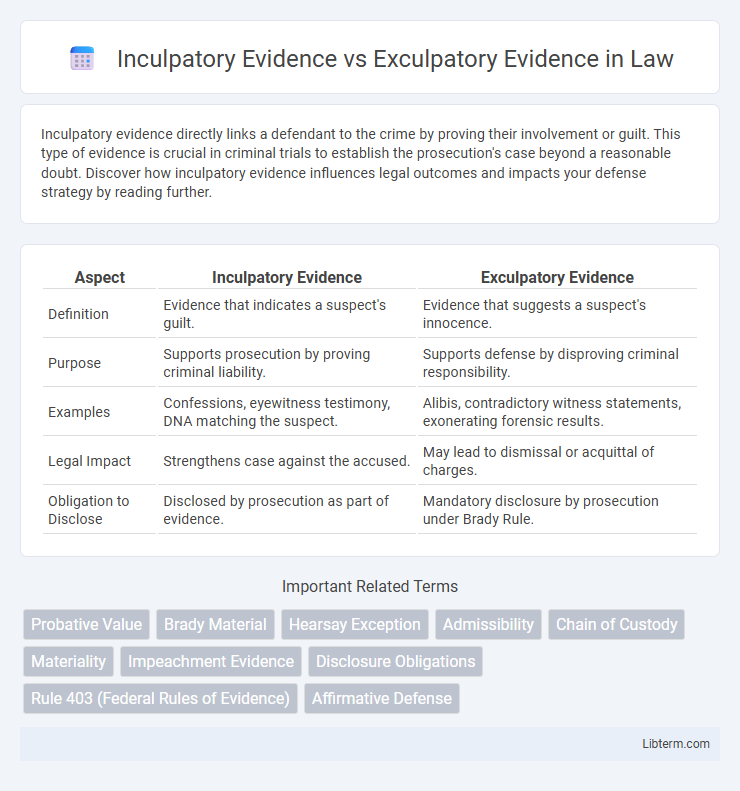Inculpatory evidence directly links a defendant to the crime by proving their involvement or guilt. This type of evidence is crucial in criminal trials to establish the prosecution's case beyond a reasonable doubt. Discover how inculpatory evidence influences legal outcomes and impacts your defense strategy by reading further.
Table of Comparison
| Aspect | Inculpatory Evidence | Exculpatory Evidence |
|---|---|---|
| Definition | Evidence that indicates a suspect's guilt. | Evidence that suggests a suspect's innocence. |
| Purpose | Supports prosecution by proving criminal liability. | Supports defense by disproving criminal responsibility. |
| Examples | Confessions, eyewitness testimony, DNA matching the suspect. | Alibis, contradictory witness statements, exonerating forensic results. |
| Legal Impact | Strengthens case against the accused. | May lead to dismissal or acquittal of charges. |
| Obligation to Disclose | Disclosed by prosecution as part of evidence. | Mandatory disclosure by prosecution under Brady Rule. |
Introduction to Inculpatory and Exculpatory Evidence
Inculpatory evidence refers to information or material that tends to prove a defendant's guilt in a criminal case, such as eyewitness testimony or forensic results linking the suspect to the crime. Exculpatory evidence, on the other hand, suggests the innocence of the accused and may include alibi statements, contradictory witness accounts, or DNA evidence that excludes the defendant. Understanding the distinction between inculpatory and exculpatory evidence is crucial for legal professionals to ensure fair trials and uphold justice.
Defining Inculpatory Evidence
Inculpatory evidence refers to any material or information that suggests the guilt of a suspect in a criminal investigation or trial. This type of evidence directly implicates the defendant by linking them to the crime, such as fingerprints, eyewitness testimony, or video footage. Contrastingly, exculpatory evidence provides information that may exonerate or absolve the defendant from blame.
Understanding Exculpatory Evidence
Exculpatory evidence refers to any information or material that can prove a defendant's innocence or reduce their culpability in a criminal case. It plays a critical role in ensuring a fair trial by requiring prosecutors to disclose such evidence to the defense under the Brady Rule. Understanding exculpatory evidence is essential for legal professionals, as it directly impacts the outcome of criminal prosecutions and protects against wrongful convictions.
Key Differences Between Inculpatory and Exculpatory Evidence
Inculpatory evidence directly links a suspect to a crime by proving their involvement or guilt, such as fingerprints or eyewitness testimony placing them at the scene. Exculpatory evidence, in contrast, suggests a defendant's innocence or undermines the prosecution's case, including alibis or DNA evidence excluding the suspect. Key differences lie in their legal impact: inculpatory evidence supports conviction, while exculpatory evidence is crucial for acquittal or mitigating charges.
Importance of Each Type in Criminal Cases
Inculpatory evidence directly links a defendant to a crime, playing a crucial role in securing convictions by proving guilt beyond a reasonable doubt. Exculpatory evidence, however, serves to prove a defendant's innocence or create reasonable doubt, ensuring fair trials and preventing wrongful convictions. The balanced evaluation of both types of evidence is essential for upholding justice and protecting the rights of the accused in criminal cases.
Legal Standards for Admissibility
Inculpatory evidence supports the prosecution by indicating the defendant's involvement in a crime, while exculpatory evidence favors the defense by suggesting the defendant's innocence. Legal standards for admissibility require evidence to be relevant, material, and not unduly prejudicial under rules such as the Federal Rules of Evidence. Courts rigorously evaluate both types to ensure fairness in trial, with the prosecution obligated to disclose exculpatory evidence under Brady v. Maryland to uphold due process.
Role in the Investigation Process
Inculpatory evidence directly links a suspect to the crime, strengthening the prosecution's case by demonstrating guilt or involvement. Exculpatory evidence, on the other hand, helps to prove the defendant's innocence or reduce culpability, often leading to acquittal or lesser charges. Both types of evidence are crucial for ensuring a fair investigation, guiding law enforcement and legal teams toward an accurate verdict.
Impact on Trial Outcomes
Inculpatory evidence directly supports the prosecution by proving a defendant's involvement in a crime, often leading to convictions or plea agreements. Exculpatory evidence tends to favor the defense by indicating the defendant's innocence or undermining prosecution claims, frequently resulting in acquittals or case dismissals. The presence or absence of either type critically influences jury decisions, judicial rulings, and the overall fairness of trial outcomes.
Common Misconceptions
Inculpatory evidence supports the prosecution's case by suggesting the defendant's guilt, while exculpatory evidence tends to clear the defendant by proving innocence or raising reasonable doubt. A common misconception is that exculpatory evidence must fully exonerate the accused, but legally it only needs to create reasonable doubt. Another misunderstanding is that inculpatory evidence alone guarantees conviction, ignoring the required burden of proof beyond a reasonable doubt in criminal trials.
Conclusion: Ensuring Justice Through Balanced Evidence
Inculpatory evidence, which tends to prove a defendant's guilt, and exculpatory evidence, which may establish innocence, are both crucial for a fair judicial process. Ensuring justice requires balanced consideration of these types of evidence to prevent wrongful convictions and uphold legal integrity. Courts must rigorously evaluate all relevant evidence to maintain equity and protect the rights of the accused.
Inculpatory Evidence Infographic

 libterm.com
libterm.com